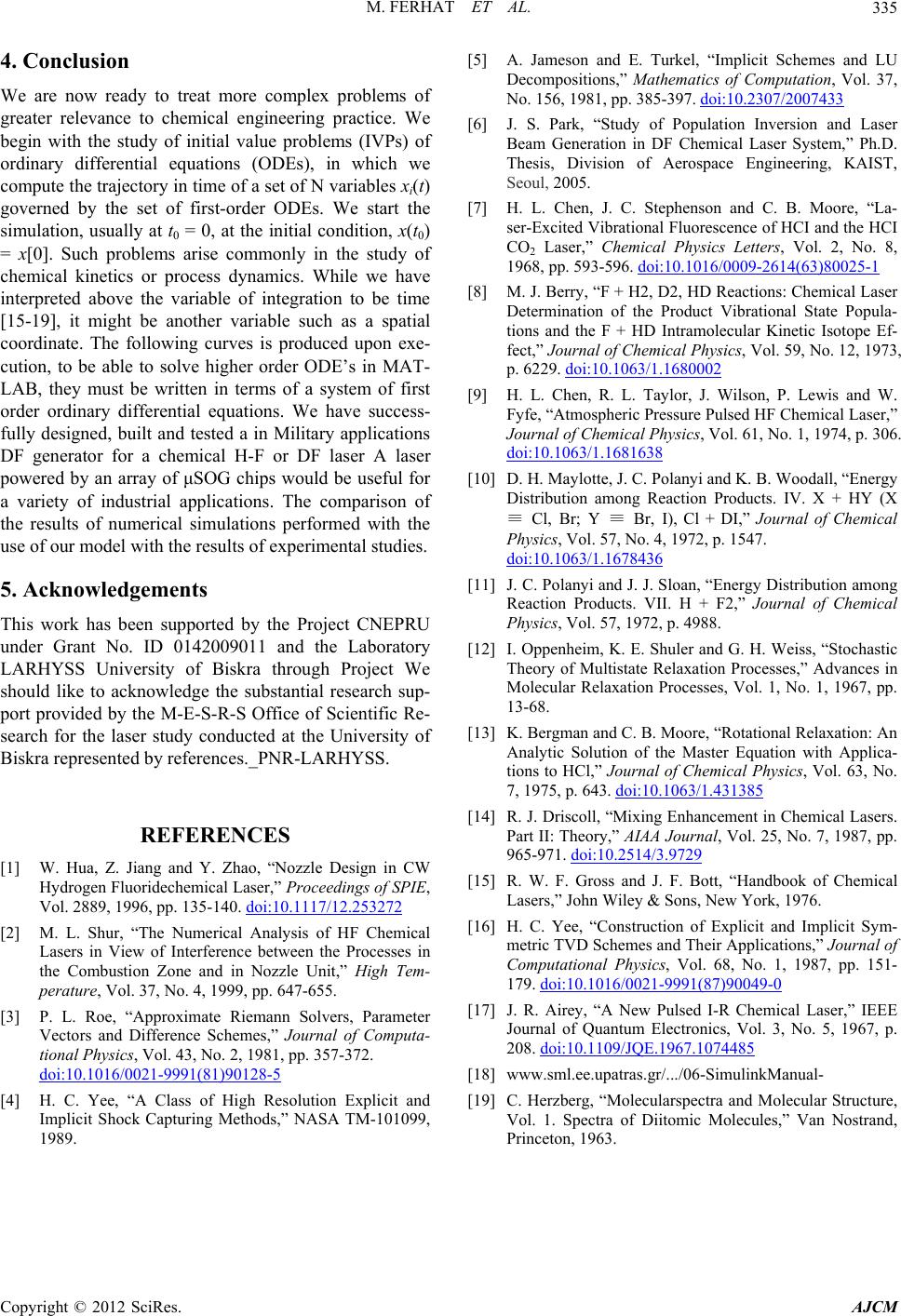
M. FERHAT ET AL.
Copyright © 2012 SciRes. AJCM
335
4. Conclusion
We are now ready to treat more complex problems of
greater relevance to chemical engineering practice. We
begin with the study of initial value problems (IVPs) of
ordinary differential equations (ODEs), in which we
compute the trajectory in time of a set of N variables xi(t)
governed by the set of first-order ODEs. We start the
simulation, usually at t0 = 0, at the initial condition, x(t0)
= x[0]. Such problems arise commonly in the study of
chemical kinetics or process dynamics. While we have
interpreted above the variable of integration to be time
[15-19], it might be another variable such as a spatial
coordinate. The following curves is produced upon exe-
cution, to be able to solve higher order ODE’s in MAT-
LAB, they must be written in terms of a system of first
order ordinary differential equations. We have success-
fully designed, built and tested a in Military applications
DF generator for a chemical H-F or DF laser A laser
powered by an array of μSOG chips would be useful for
a variety of industrial applications. The comparison of
the results of numerical simulations performed with the
use of our model with the results of experimental studies.
5. Acknowledgements
This work has been supported by the Project CNEPRU
under Grant No. ID 0142009011 and the Laboratory
LARHYSS University of Biskra through Project We
should like to acknowledge the substantial research sup-
port provided by the M-E-S-R-S Office of Scientific Re-
search for the laser study conducted at the University of
Biskra represented by references._PNR-LARHYSS.
REFERENCES
[1] W. Hua, Z. Jiang and Y. Zhao, “Nozzle Design in CW
Hydrogen Fluoridechemical Laser,” Proceedings of SPIE,
Vol. 2889, 1996, pp. 135-140. doi:10.1117/12.253272
[2] M. L. Shur, “The Numerical Analysis of HF Chemical
Lasers in View of Interference between the Processes in
the Combustion Zone and in Nozzle Unit,” High Tem-
perature, Vol. 37, No. 4, 1999, pp. 647-655.
[3] P. L. Roe, “Approximate Riemann Solvers, Parameter
Vectors and Difference Schemes,” Journal of Computa-
tional Physics, Vol. 43, No. 2, 1981, pp. 357-372.
doi:10.1016/0021-9991(81)90128-5
[4] H. C. Yee, “A Class of High Resolution Explicit and
Implicit Shock Capturing Methods,” NASA TM-101099,
1989.
[5] A. Jameson and E. Turkel, “Implicit Schemes and LU
Decompositions,” Mathematics of Computation, Vol. 37,
No. 156, 1981, pp. 385-397. doi:10.2307/2007433
[6] J. S. Park, “Study of Population Inversion and Laser
Beam Generation in DF Chemical Laser System,” Ph.D.
Thesis, Division of Aerospace Engineering, KAIST,
Seoul, 2005.
[7] H. L. Chen, J. C. Stephenson and C. B. Moore, “La-
ser-Excited Vibrational Fluorescence of HCI and the HCI
CO2 Laser,” Chemical Physics Letters, Vol. 2, No. 8,
1968, pp. 593-596. doi:10.1016/0009-2614(63)80025-1
[8] M. J. Berry, “F + H2, D2, HD Reactions: Chemical Laser
Determination of the Product Vibrational State Popula-
tions and the F + HD Intramolecular Kinetic Isotope Ef-
fect,” Journal of Chemical Physics, Vol. 59, No. 12, 1973,
p. 6229. doi:10.1063/1.1680002
[9] H. L. Chen, R. L. Taylor, J. Wilson, P. Lewis and W.
Fyfe, “Atmospheric Pressure Pulsed HF Chemical Laser,”
Journal of Chemical Physics, Vol. 61, No. 1, 1974, p. 306.
doi:10.1063/1.1681638
[10] D. H. Maylotte, J. C. Polanyi and K. B. Woodall, “Energy
Distribution among Reaction Products. IV. X + HY (X
≡ Cl, Br; Y ≡ Br, I), Cl + DI,” Journal of Chemical
Physics, Vol. 57, No. 4, 1972, p. 1547.
doi:10.1063/1.1678436
[11] J. C. Polanyi and J. J. Sloan, “Energy Distribution among
Reaction Products. VII. H + F2,” Journal of Chemical
Physics, Vol. 57, 1972, p. 4988.
[12] I. Oppenheim, K. E. Shuler and G. H. Weiss, “Stochastic
Theory of Multistate Relaxation Processes,” Advances in
Molecular Relaxation Processes, Vol. 1, No. 1, 1967, pp.
13-68.
[13] K. Bergman and C. B. Moore, “Rotational Relaxation: An
Analytic Solution of the Master Equation with Applica-
tions to HCl,” Journal of Chemical Physics, Vol. 63, No.
7, 1975, p. 643. doi:10.1063/1.431385
[14] R. J. Driscoll, “Mixing Enhancement in Chemical Lasers.
Part II: Theory,” AIAA Journal, Vol. 25, No. 7, 1987, pp.
965-971. doi:10.2514/3.9729
[15] R. W. F. Gross and J. F. Bott, “Handbook of Chemical
Lasers,” John Wiley & Sons, New York, 1976.
[16] H. C. Yee, “Construction of Explicit and Implicit Sym-
metric TVD Schemes and Their Applications,” Journal of
Computational Physics, Vol. 68, No. 1, 1987, pp. 151-
179. doi:10.1016/0021-9991(87)90049-0
[17] J. R. Airey, “A New Pulsed I-R Chemical Laser,” IEEE
Journal of Quantum Electronics, Vol. 3, No. 5, 1967, p.
208. doi:10.1109/JQE.1967.1074485
[18] www.sml.ee.upatras.gr/.../06-SimulinkManual-
[19] C. Herzberg, “Molecularspectra and Molecular Structure,
Vol. 1. Spectra of Diitomic Molecules,” Van Nostrand,
Princeton, 1963.